What if the most famous medieval horse race in Italy… wasn’t actually the oldest?
Everyone knows the renowned Palio of Siena, but few are aware that deep in the heart of the Marche region lies a horse race and historical reenactment that’s even older, a tradition rooted in a time when faith, power, and a community’s sense of identity came together in a single, solemn procession.
Every year in Fermo, on the eve of the Feast of the Assumption, the entire city pauses to look back and rediscover itself through the historical reenactment of the Cavalcata dell’Assunta. It’s more than a festival, it’s a collective return to the origins, to a time when devotion to the Virgin Mary shaped the spiritual, social, and political life of the region.

The ancient history of Cavalcata dell'Assunta
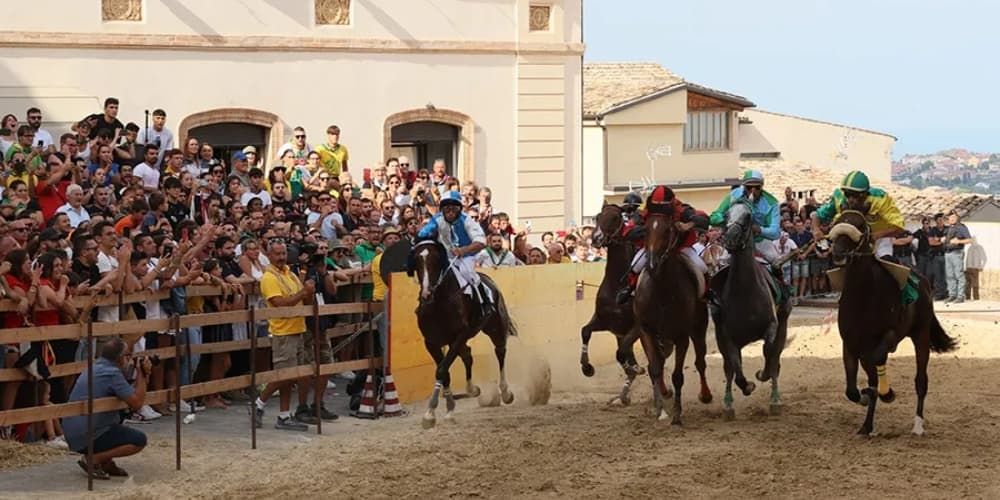
As can be seen from various historical documents, the Cavalcade was the processional parade that took place on the evening of August 14th, the eve of the feast.
As early as the 5th century, a church dedicated to Santa Maria in Castello stood on the Girfalco (the highest point of the city), a sign of a millennia-old devotion. Documents dating back to 998 mention a procession for the feast of the Virgin Mary, the city's patron saint. In a document from 1182, Monterubbiano, Cuccure, and Montotto reiterate that they would bring a palio to Fermo every year in honor of the Virgin.
That document is the key evidence that makes the Cavalcata dell’Assunta the oldest Palio in Italy.
From that moment on, Fermo and its surrounding villages came together (or sometimes competed) in this grand celebration. While it was undoubtedly an act of faith, the Cavalcata was also a powerful statement of identity. Each small village contributed to honoring the patron saint, Santa Maria Assunta into Heaven, with lavish processions, festively adorned horses, games, and spirited competitions.
This dual nature, both religious and political, was officially recognized in the Statuta Firmanorum of 1382, the civic code of the time, which described the structure and customs of the Cavalcata in detail. Even today, a beautifully illustrated page from 1436 by Giovanni, son of Master Ugolino from Milan, preserves a vivid image of that processional parade, like a full-color photograph that has travelled through the centuries.
The procession started from the Church of Santa Lucia and went up to the Cathedral, passing through the streets accompanied by music, banners, representatives of the guilds and crafts, and the castles subordinate to the city, and finally the authorities of the time: a collective ritual that culminated in a large fair, various games, including a horse race where participants competed to win the banner.
Today, Fermo is divided into ten contrade. Six belong to the historic city center, while four are known as foranee, born outside the medieval walls.
Listen to the podcast version of the article with the voice of Monna Lisa & Leonardo
What to expect: the highlights of the Cavalcata dell’Assunta
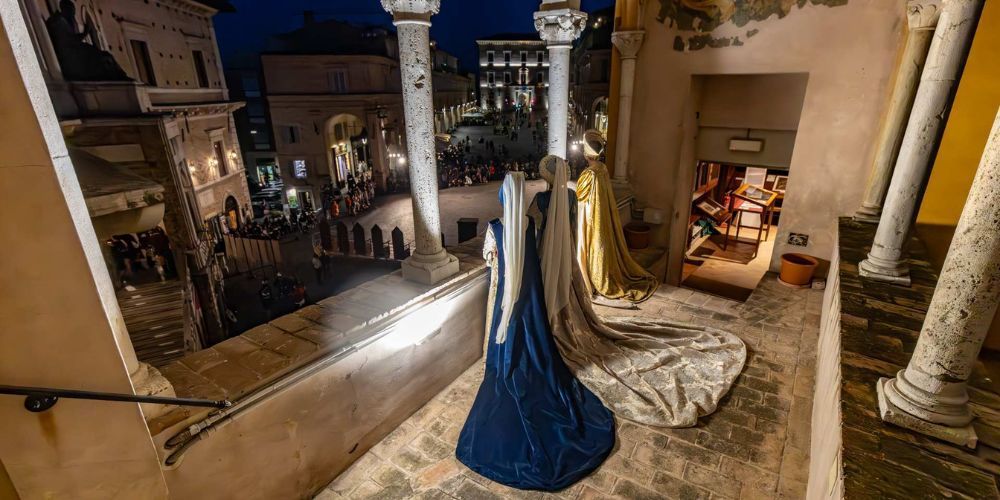
The Cavalcata dell’Assunta isn’t just a date on the calendar, it’s an entire season pulsing with anticipation, preparations, and shared emotion. It all begins quietly, a hundred days before the race, and builds up to a final night that shimmers beneath the stars of Ferragosto. In Fermo, as early as May, the air begins to change and very step toward August 15 is marked by rituals that taste of history.
The Investitura dei Priori, the official appointment of the district leaders, is one of the most solemn moments: a ceremony in which each contrada chooses its representatives, not only to lead, but to embody a deep-rooted sense of belonging.
Then, by late July, excitement is almost tangible. Everyone is waiting for the arrival of the Palio, the painted banner, rich in symbolism, which is handed over during a stirring ritual by the Pentecost Army of nearby Monterubbiano. From that moment, the countdown intensifies and so do the preparations.
The Tamburini competitions for the “Gallo d’Oro” Trophy are a proud celebration of rhythm and discipline, each beat of the drum echoes with the passion of a contrada. Then it’s time for the flags to soar: the Bandiere al Vento contest sees the flag-throwers perform dizzying displays of coordination and acrobatics that leave the crowd breathless.
August opens with performances by the Alfieri e Musici of the Cavalcata, turning city squares into open-air stages where artistry meets centuries-old tradition. Meanwhile, in hushed concentration, the Tratta dei Barberi takes place: the much-awaited draw pairing each contrada with a horse for the Palio. It’s a moment dense with tension, where fate and strategy intertwine, and a single name can tip the balance of the race.
Then comes August 14. The historical procession by night is among the most magical events of the festival. 1400 costumed participants weave through the torch-lit streets, dressed in richly detailed attire inspired by the 15th century. The night ends in the Cathedral of Fermo, where the Archbishop solemnly blesses the Palio during a moving liturgical ceremony.
And finally, August 15.
The morning begins with the ceremonial delivery of the racing silks to the jockeys. In the afternoon, the entire city moves toward the racecourse. The contrade march in formation, drums beat louder, flags sweep through the air. And then, a moment of silence. Two preliminary heats, followed by the final.
The horses burst forward, dust swirls, hearts race.In the end, only one contrada will claim the Palio. Then came Festa della Vittoria (Victory Celebration) in Piazza del Popolo.
Cavalcata dell’Assunta when and where: plan your trip to Fermo, Italy
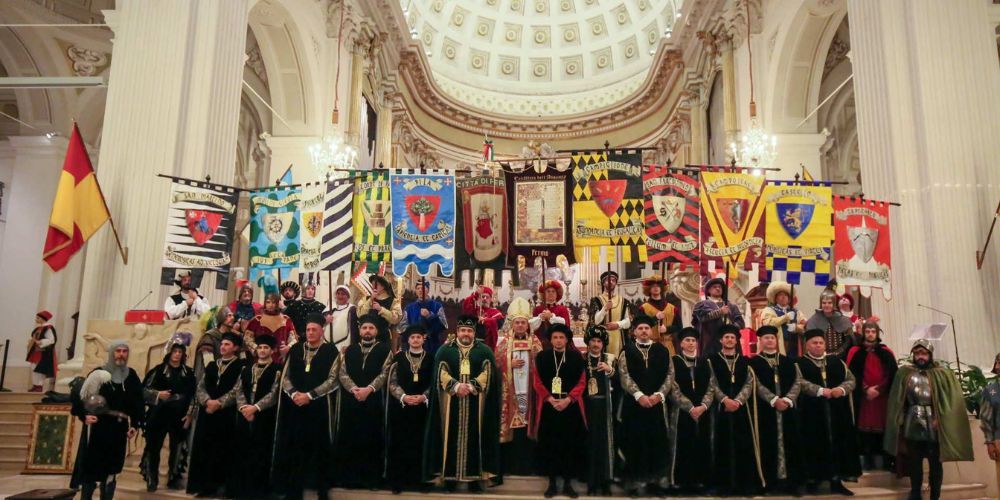
If there’s a moment when Fermo truly shines, it’s between August 8 and 15. In these seven days, the city wraps itself in history, emotion, and pride. But the Cavalcata dell’Assunta isn’t just a reenactment, it’s a full-bodied experience, something to live with every sense.
Festivities begin on Friday, August 8 at 9:30 PM at the Castle of Torre di Palme with the Reading of the Proclamation and the Historical Parade.
On Saturday, August 9 at 9:30 PM, one of the most beloved events returns: the performance by the Musicians and Flag-Throwers of the Cavalcata dell’Assunta. Piazza del Popolo transforms into a stage of dazzling skill and powerful rhythms.
On Monday, August 11 from 7:30 PM, the city comes alive with “The Night of Desires – Waiting for the Tratta” in Piazza del Popolo. The following evening, Tuesday, August 12 at 9:30 PM, it’s time for the "Tratta dei Barberi": the costumed ceremony in which the horses are officially assigned to each contrada.
But it’s on August 14 that Fermo becomes a true medieval dream. Starting at 8:45 PM, from the Church of Santa Lucia to the Cathedral, the 15th-century Historical Parade takes place by night: over a thousand participants in period costume march through the city with torches, banners, and drums. The evening becomes even more solemn with a liturgy of the word and the blessing of the Palio by the Archbishop. Immediately afterward, in Piazza del Popolo, the heats for the Palio are drawn.
On August 15, the morning opens at 10:30 AM with the delivery of racing silks to the jockeys inside the Cathedral. At 11:30 AM, the Solemn Pontifical Mass of the Assumption, celebrated by H.E. Rocco Pennacchio, Archbishop of Fermo, marks the spiritual heart of the celebration.
Then, at 3:00 PM, the historical parade comes back to life and moves toward the racecourse, from Piazza del Popolo to Viale Vittorio Veneto. At exactly 5:00 PM, the Palio begins on Via XX Settembre and Viale Vittorio Veneto: two qualifying heats, one final, and only one winning contrada.
The day concludes with the Victory Celebration at 9:30 PM in Piazza del Popolo. The triumphant contrada celebrates with music, toasts, and cheers that rise into the night, until midnight, when the winning number of the prize raffle is drawn.
To view the full 2025 schedule, visit the official Cavalcata dell’Assunta website.
How to get to Fermo
Getting to Fermo is easier than you might think. By car, simply take the A14 Bologna–Taranto highway, exit at Fermo–Porto San Giorgio, and follow a convenient six-kilometer expressway to the city center.
If you’re traveling by train, head to Fermo–Porto San Giorgio station, located on the Adriatic railway line and connected to the city by regular shuttle buses running every 30 minutes. Long-distance buses are also a solid option, with daily direct routes between Fermo and Rome provided by intercity lines.
For those arriving by air, the nearest airport is “Raffaello Sanzio” in Falconara, near Ancona. From there, you can reach Fermo by car via the A14, by train with a connection from Castelferretti and Ancona stations, or by bus using the regional coach services.
Experience the Palio Cavalcata dell'Assunta like a local
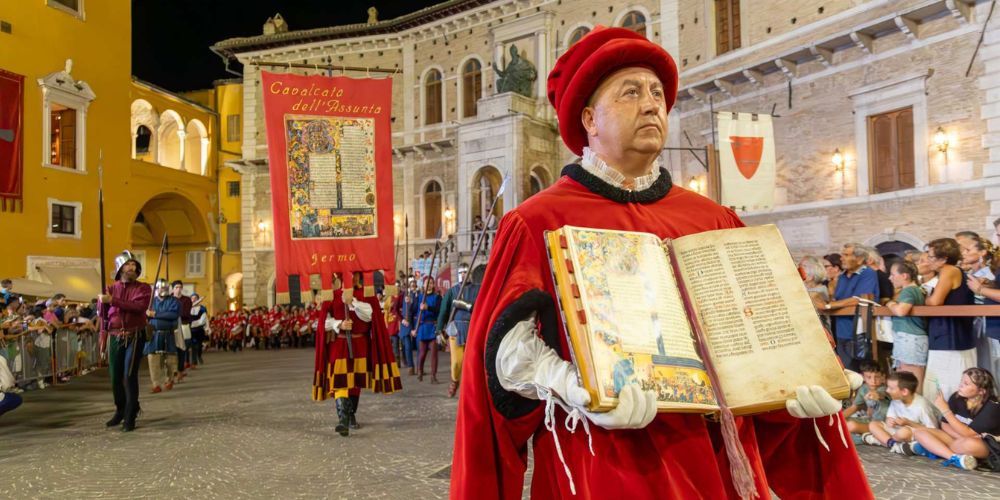
To truly live the Cavalcata dell’Assunta, you have to do as the people of Fermo do: find the perfect viewing spot, savor the flavors of home, let yourself be swept away by the beat of the drums, and dive headfirst into an atmosphere rich with history and belonging.
Watching the Palio race isn’t something to leave to chance, it takes strategy. The locals know it well, and from early afternoon they begin to claim the best spots along the course. The curves are the real heart of the race: it’s there that the horses slow, the jockeys show their skill, and the tension is so thick you could cut it with a breath. If you manage to get a spot here, prepare to hold your breath and feel every hoofbeat reverberate through your chest.
Piazza del Popolo is undoubtedly the most iconic viewing point, but also the most crowded.
If you’re after a calmer perspective, you might find quieter, alternative views from the side streets. The horses pass quicker here, but the energy is still electric.
For those who prefer comfort, some areas have bleachers with excellent visibility, but spots are limited and must be booked in advance.
And if the spectacle whets your appetite, you’re in luck: Fermo knows how to feed the soul, and the stomach.
During the festival, contrada hostarie open their doors only for the occasion, turning into rustic medieval inns.
Try the vincisgrassi, the rich and layered ancestor of lasagna, lovingly baked to perfection. Or sample olive ascolane, golden-fried and stuffed with a savory filling. And don’t miss the ciauscolo, the spreadable salami that tastes like Marche itself.
Between bites, stroll through the artisan stalls scattered throughout the historic center: you’ll find handcrafted leather goods, medieval-inspired trinkets, banners in the colors of each contrada, and hand-painted ceramics. Treasures made with care, not for tourists, but as expressions of tradition.
And if you truly want to feel part of the city, wake early on the morning of August 15 to reach the Cathedral and participate in the delivery of the jackets to the jockeys.
Stay, too, for the Pontificale dell’Assunta. Under the soaring vaults of the Metropolitan Cathedral, you’ll breathe the same devotion that has stirred the hearts of Fermo’s people for centuries.
A hidden gem in the Marche: why Fermo deserves your attention
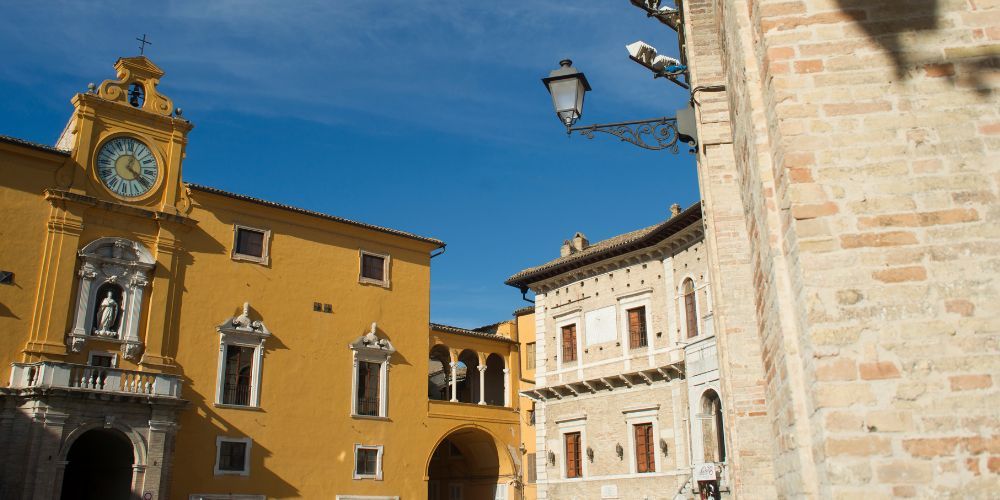
As you wander through the streets of Fermo, you’ll immediately sense a rare authenticity, something that many of the more famous destinations have long since lost. No tourist traps, no artificial shopfronts. Here, time still moves at its own natural rhythm.
And then there’s the Girfalco. Climbing to the hilltop that watches over the city is almost a ritual. From up there, the view stretches wide across the rolling hills of the Marche, all the way to the shimmering Adriatic Sea.
But Fermo is also history carved in stone, knowledge lovingly preserved: the Civic Library "Romolo Spezioli' and the Civic Art Gallery at Palazzo dei Priori, with its Globe Room, are little-known wonders of immense value. The Library houses ancient manuscripts, incunabula, and a collection of miniatures that, centuries later, inspired the costumes of the Cavalcata dell'Assunta.
And beneath your feet lies another wonder: the Roman cisterns. This vast hydraulic system, built in the first century AD, is one of the largest and best-preserved in Europe. Walking through its cool, silent underground chambers is like stepping into a different era, a distant past that still has much to whisper.
Fermo is a city to explore slowly, to fall in love with through its details and silences. A haven for those seeking something real, far from the well-trodden tourist trails.
Beyond Cavalcata dell'Assunta: what to do in Fermo
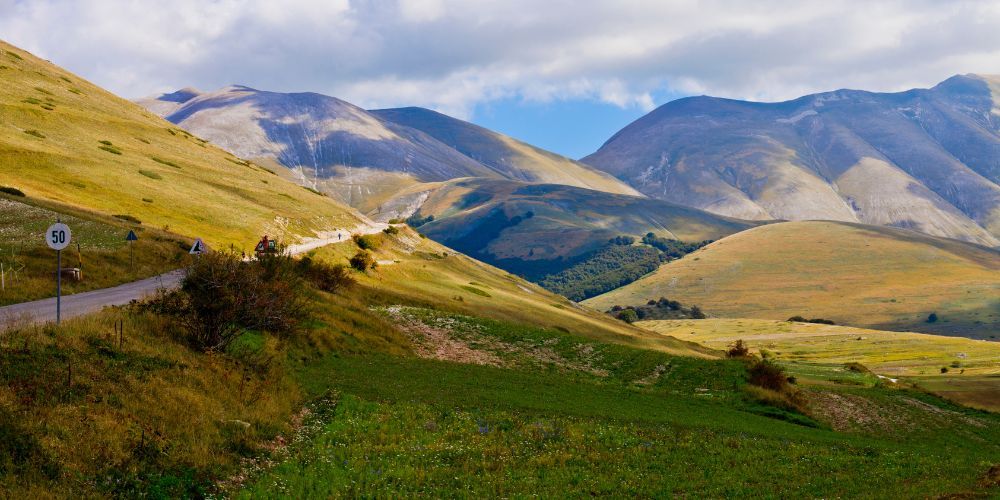
When the drums fall silent and the banners are lowered, Fermo reveals its true self: an elegant, intimate, and quietly astonishing city.
The perfect place to start discovering it is Piazza del Popolo, one of the most enchanting squares in the Marche region. With its porticoes, loggias, and Renaissance facades, it stretches like a long corridor of arches across a 15th-century urban layout. At its far end, the square opens up like a curtain lifting on a scene of open-air cafés, soft chatter, and the unhurried pace of locals strolling by. On either side, the symbols of civic power and cultural pride rise tall: the Palazzo dei Priori and the Civic Art Gallery. Inside, masterpieces of art and history unfold through archaeological collections and priceless paintings.
From there, a gentle uphill walk leads to Colle del Girfalco, crowned by the Metropolitan Cathedral of the Assumption. Monumental and austere, its Romanesque-Gothic façade commands attention. Built atop the ruins of a pagan temple and reconstructed by Frederick II in 1227, the cathedral houses paleochristian mosaics, ancient sarcophagi, and a mysterious Byzantine icon.
Also to be admired are the splendid works kept in the Diocesan Museum, including the Missale of the Firmonibus family, which inspired the Cavalcade of the Assumption, and the chasuble of Thomas Becket, once gifted to a bishop of Fermo.
From its panoramic terrace, your gaze drifts across hills, sea, and sky, in one of the most breathtaking views in all the Marche.
But that’s just the beginning.
Head down to the coast and you’ll reach Lido di Fermo: soft sandy beaches, calm waters, and beach bars along the promenade invite you to slow down and simply enjoy. It’s a place made for easy days and gentle evenings by the sea.
If you're willing to venture a little further, the Riviera del Conero awaits like a gift from nature. This stunning stretch of coastline looks painted by hand, where the deep green of Mediterranean scrub meets the sapphire blue of the Adriatic. Sirolo, Numana, Portonovo, charming villages nestled between cliffs and pebble coves, are perfect for lazy swims, scenic walks, and fresh seafood meals with a view of the waves.
Look inland, and you’ll discover a constellation of medieval villages that seem lifted from a storybook: Torre di Palme, with its flower-lined alleys and panoramic vistas; Moresco, shaped like a hexagon and guarded by a 14th-century tower; and Monterubbiano, a treasure trove of ancient flavors and traditions.
And for those drawn to wilder landscapes, the Sibillini Mountains offer fairytale scenes: high mountain pastures, glacial lakes, and hiking trails that wind through myths and silence. Here, you can breathe deeply, immersed in a landscape that feels both magical and primordial.
5 fascinating facts you (probably) don’t know about the Cavalcata dell’Assunta
Behind every roll of the drum and each flag that dances in the August sky, the Cavalcata dell’Assunta holds stories, secrets, and traditions that make it truly one of a kind in the world of Italian historical reenactments.
1. The first surprise? The Cavalcata dell'Assunta is one of the oldest historical reenactments in Italy. This is stated by documents, not legends. It was in 1182 when Monterubbiano, Cuccure, and Montotto brought a Palio to Fermo in honor of the Assumption, a century before other important historical events.
2. And beneath your feet, as the contrade parade through the streets, lies an invisible treasure: the Roman cisterns. Built in the 1st century AD, this vast hydraulic system is one of the largest in Europe. A labyrinth of underground chambers that, during certain times of the year, opens to visitors for a journey into the hidden heart of the city.
3. The costumes worn during the parade also tell their own story. They are not mere medieval replicas, but highly accurate reproductions inspired by 15th-century miniatures preserved in the Civic Art Gallery of Palazzo dei Priori and in paintings found in churches and museums throughout the area.
4. And then there’s the taste of anticipation, literally. During the Cavalcata dell'Assunta, contrada hostarie open only for a few special days, transforming into medieval-style inns. Here, guests are welcomed with menus rooted in local traditions. Seated on long wooden benches, surrounded by colorful banners and sincere laughter, you feel a rare and beautiful sense of community.
5. Finally, a moment that leaves a mark: the selection of the barberi horses. The atmosphere heats up and the tension rises as the Priors of each Contrada are called by the Podestà to draw the name of the horse assigned to them by 'fate.' The silence of the square during these crucial moments creates a unique atmosphere that only those present can experience.
About the author
Written on 08/08/2025


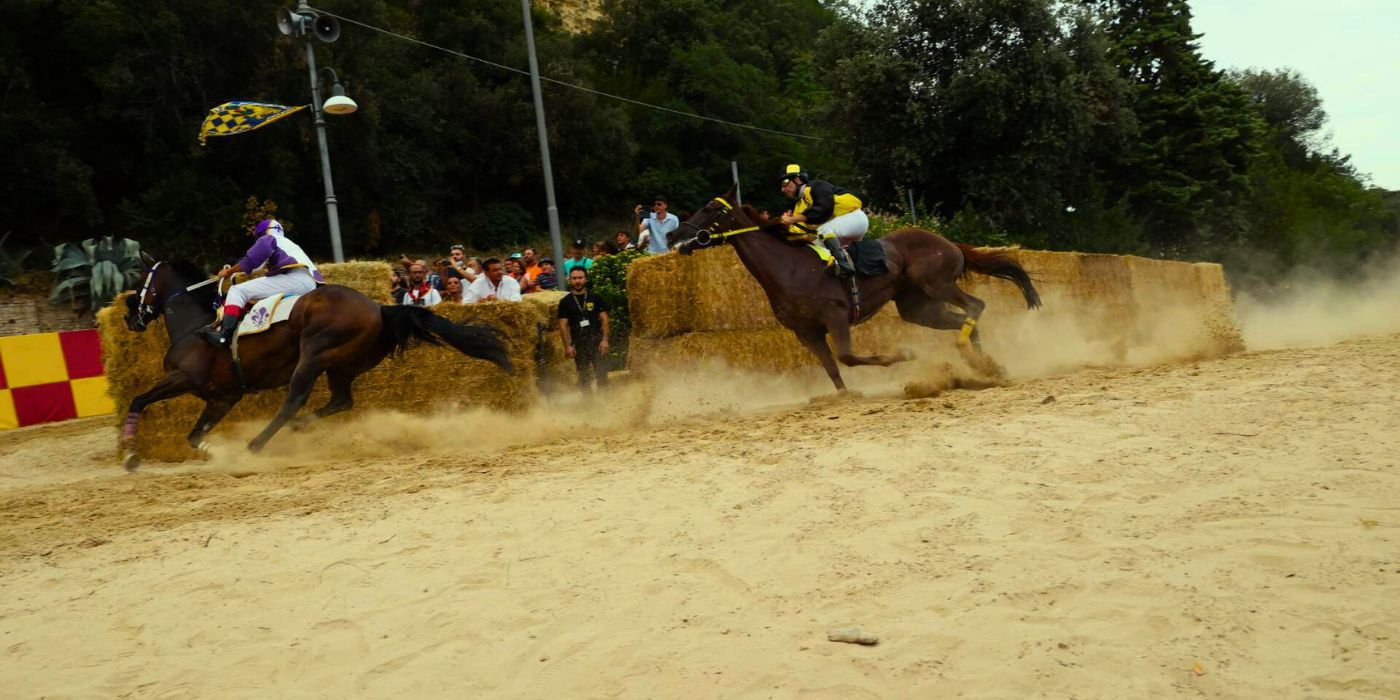

Flavia Cantini
Italy’s oldest Palio isn’t in Siena: discover Fermo’s Cavalcata dell’Assunta, a heartfelt dive into history and Marche’s true soul.